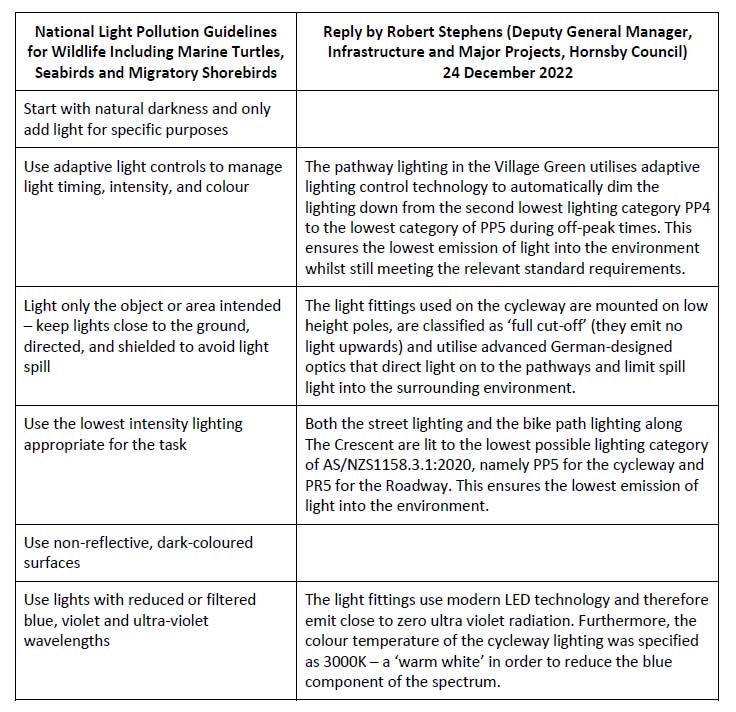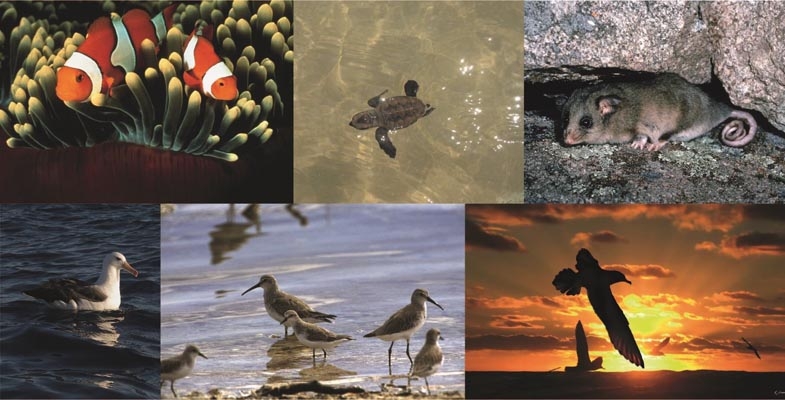In 2018 the Powerful Owl Coalition highlighted the importance of reducing artificial lights near bushland in the publication Protecting Powerful Owls in Urban Areas. They recommended avoiding public lighting that illuminated the full height of trees as this would impact both Powerful Owls and their prey and keeping lighting, particularly bright artificial sports lighting, away from riparian areas, other core habitat and nesting sites.
Since then, the Powerful Owl Coalition, STEP, Byles Creek Valley Union, PYSE Inc and the Powerful Owl Project of Birdlife Australia have been writing to Hornsby Council and other authorities about the importance of darkness for fauna, both nocturnal and diurnal as the ratio of light to darkness helps regulate many aspects of wellbeing for fauna.
Indeed, the effects of artificial light at night can be so profound that it can change reproduction, feeding, sleep, and protection from predators to the degree that apparent habitat cannot be used by some fauna species.
Since 2018 most of our submissions addressed artificial light proposals for Hornsby Park (the Quarry) and Westleigh Park as the proposals for increased use of these sites would include night lighting. Both these sites include known populations of Powerful Owls which have a conservation status in NSW of vulnerable to extinction.
In December 2022 the Powerful Owl Coalition wrote to Hornsby Council about the Beecroft to Cheltenham Bike Track, a track that passes through an area famed for its Powerful Owl population. As a result, council contacted the Powerful Owl Project and discussed these matters further with their co-ordinator.
As a result of the submission and these discussions, the Powerful Owl Coalition received a prompt reply from council. They were overjoyed. Huge steps have been made for the protection of wildlife, not just Powerful Owls, by the proposed lighting for the bike track and in the revised Australian Standard AS4282.
The specifications for lighting the Beecroft to Cheltenham Bike Track align well with the National Light Pollution Guidelines for Wildlife Including Marine Turtles, Seabirds and Migratory Shorebirds (Australian Government, 2020).
Further comments from council’s reply are given below:
The Coalition may be interested to know that our lighting consultant actually sits on the AS4282 committee as a co-opted expert and that the new revision of the standard (which should be coming out next year) includes spill lighting limits for Environmentally Sensitive Areas which includes ‘naturally dark areas including bushland, waterways, marine and coastal areas’.
The new standard will consider the impacts of spill lighting on plants, wildlife and ecosystems by applying limits when previously there were none. To the best of our consultant’s knowledge this is the first normative obtrusive lighting standard in the world to consider the impact upon biota.
Hopefully this should give the Coalition some comfort that the numerous stakeholders on the committee (formed by government, industry and lighting experts) are taking the matter of protecting our unique night time habitats seriously.
Suffice to say I am advised that council’s consultant has taken every effort to minimise light spill beyond the target area and into the canopy and that they ‘strongly believe in protecting the night time environment and [their] approach is to use best practice design to minimise light pollution/spill whilst still achieving the objectives of the project.
The Powerful Owl Coalition thank Hornsby Council for engaging such a knowledgeable and forward thinking consultant, for caring about the fauna of the ‘bushland shire’ and for using these standards before publication.
We look forward to these standards being applied in Hornsby and Ku-ring-gai, particularly in developments in and adjacent to bushland such as Hornsby and Westleigh Parks and Norman Griffiths Oval.


